by Nicholas Caleb and Adam Rothstein
When the Portland Police tell you that your language is “hostile and escalating,” it is probably a cause for concern.
This is what happened on the evening of February 6th, when many people from Occupy Portland first found out about an Anti-Police Brutality March via a Porland Police Bureau press release. The March in Portland, in solidarity with a march called by Occupy Oakland the same day, was actually not organized by Occupy Portland or approved by the General Assembly. However, police brutality and threats to the media and free speech are issues that concern many Occupy activists. And so, hearing of the event, many decided to attend.
However, the press release put out by PPB was troubling at best. It said:
Police are concerned about tonight’s rally and march because the tone and content of available information is decidedly more hostile and escalating.
This statement is similar in tone to other statements made by the mayor and police officials before serious escalations of police tactics to the point of violence, such as those made prior to the eviction of Occupy Portland from Chapman and Lownsdale Parks, and surrounding the infamous pepper spray and beatings that occurred on November 17th, 2011. Accusations of hostility often accompany increased hostility on the part of the police, in an attempt to paint a picture of their actions as reactions. It is almost as though the police were seeding their narrative ahead of time.
But that did not sway the protesters, who came out to rally against police brutality and in support of Oakland, where over 400 people were gassed, shot, beaten, and arrested on January 28th, including journalists, while only 12 of those people were ever charged with a crime. The Portland march was about a hundred people strong at its largest point. Beginning in Colonel Summers Park at Belmont and SE 20th Ave, it would wind its way around the close-in Southeast Portland for three hours.
The protest began with controversy. After marching through some back streets holding banners and chanting, a number of individuals, perhaps no more than three, began smashing a few windows of cars as they passed. There was some spray painting, and the glass of the front door of Genoa, a restaurant on Belmont at SE 28th Ave, was punctured twice with a metal flagpole.
The fighting that resulted was not with the police, of whom at this point nothing was to be seen. It was between protesters, as those who were for the “black bloc” like property destruction as an expression of civil disobedience and rage against police violence, got into shoving matches with those who were happy to march in the streets, but did not want to alienate the neighborhood.
The middle of the street is hardly the place for a tactical discussion, and passions and egos being inflamed as they were, protesters had to pull protesters off of other protesters. Discussion became shouting, and consensus procedure took a far back seat to the realities of the street. One masked and hooded protester shouted, “If you’re more worried about a broken window, why don’t you go the fuck home?” Another protester said to a friend later during a break, about the people doing property destruction, “a lot of these people say, ‘training, I don’t need training!’ And then they get here, and this [shouting] happens. All I see are disorganized, egotistical people.”
But just as it was beginning to seem as if this march might be a tactical disaster–not for any wrong tactic being selected, but for none of the protesters having any clue how to coalesce their tactics with others in a sensible way–the police showed up, and galvanized the event.
The endless arguments pro/contra property destruction would have to wait. Mounted police and bike police showed up first, when the march was heading east on Alder, near SE 30th Avenue. The public address system van, otherwise known as the ice cream truck, appeared and began broadcasting that the street which the protesters were marching in, was to be reopened to traffic. Any protesters remaining in the street would be subject to arrest, and if necessary, chemical and impact weapons would be used. After police established a presence, protesters did not have to wait long for the brutality that they came to rally against to materialize.
The first attempt by the police to clear the street was a failure. Multiple vans, with riot-gear wearing officers clinging to the sides swooped east on Belmont, and attempted to pin the protesters between their line and the bicycle police coming from the rear. The protesters merely divided in half, and ran in either direction. The riot police ended up making a line blocking the bicycle police–perhaps in the glare of the headlights, they took them to be protesters on bikes. Or perhaps, they were just unsure of whether to break their lines.
The persons who had actually committed the acts of vandalism quickly left the scene, and were not apprehended by police. The police, for their part, changed their tactics quickly. Instead of lining up to clear the streets, the riot police began bum-rushing protesters on the sidewalk, in violent snatch-and-grab maneuvers, who clearly had not been among those destroying property. They would swoop up on their vans, leap off, tackle a few protesters to the ground, and make a line to prevent the shocked protesters on the sidewalk from helping their compatriots as they were pinned to the pavement. There was a wave of four arrests on Belmont, as peaceful protesters were slammed to the ground, zip-tied, and then shoved into the back of vans. The police later reported that these arrests were made because the protesters went into the streets or interfered with police actions, though many were only walking on the sidewalk, and were singled out for unknown reasons. One protester who was arrested, named Nefi, claimed that a bike police officer came at him with a glass bottle as he walked on the sidewalk on the north side of Belmont.
A member of Occupy Portland’s PR team, Emmalyn, was on the sidewalk when she was grabbed by the hair by the police and pulled into the street. “I was standing on the sidewalk on Belmont Street, when an officer ran up behind me, grabbed me by the hair, and shoved my face into the pavement, breaking my glasses in half and cutting my face. I was arrested for standing on a sidewalk at an anti-police brutality march. The police are out of control.” Here she is, being inteviewed by Paul for The Portland Occupier:
A second wave of protesters, mostly recognizable from previous Occupy protests and events, gathered about a block north of Colonel Summers Park just as the first wave was dispersed by police. They began marching south on SE 20th Avenue until they reached Hawthorne. Here, riot police, supported by mounted and bicycle police, swooped out again. Scared, a number of protesters ran down SE Elliot Avenue. One young man, identified only as Jordan H, was tackled on the front lawn of a suburban home by a bicycle cop who rode up on the sidewalk to grab him. Reporter for The Portland Occupier, Adam Rothstein, [one of the co-authors of this article] witnessed what happened next:After a prolonged presence and not much action after these arrests, the police again dispersed and the march continued east on Hawthorne.Quickly, three other officers on bicycles joined in pinning Jordan H., including one single officer in full riot gear who ran over, whose name tag identified him as Officer Thurman. They had him on the ground, on his stomach. I was no more than ten feet from them, and I was alone, having run forward with my camera to see what was happening. It was too dark on that patch of street for a photo, but the officers were quite visible in the light from the porch of the house. I heard the officers yelling at Jordan, telling him to take his arm out of the backpack he was wearing. “I can’t! It’s stuck!” he protested. Without giving him a second chance, Officer Thurman, with his knee squarely on Jordan’s shoulder blades, pulled back his arm and punched Jordan three times in the kidneys. I heard his fist hit flesh with a sickening thud, as the other officers held their prisoner by the arms.
Suddenly, I was frightened myself. I realized that there was no one else around. These officers could turn on me, and arrest me, and break my camera. They could haul me off to jail, and beat me. They could do whatever they wanted to me, say I did whatever they wanted to say I did. And no one could stop them, because they had badges, and I only had a camera.I put on my toughest, most official, reporter-sounding voice, and asked the bicycle officer who was eyeing me and keeping me back (though I had no desire to get any closer) what Jordan was charged with. He would not tell me. I asked to verify Officer Thurman’s name. He would not. Thurman got up, and saw that I was interested in him. I asked him his name directly, and he would not tell me. He said, “I don’t need to talk to you.” He walked back to the van he rode in on, accompanied by other officers, without ever telling me his name. I ran after him, and as soon as he got into the direct light, I took a good look at his name tag, to solidify it in my mind. Later, when I saw him again, I took a picture of his face. He was easy to spot, being about 6’5”, and with a large black helmet marked with the number 82.
I went back, and watched as they held Jordan to the ground for over fifteen minutes. He begged them to let him up, to just let him go home. “All I did was run away,” he said. “I just wanted to practice my freedom of speech.”
However, the police soon regrouped to meet the protesters on the sidewalk outside of Artisan Dental at SE 26th Avenue and Hawthorne. The riot police, now numbering around one hundred, seized two individuals from the sidewalk in forceful maneuvers so quick that they took the crowd completely by surprise. Then, after forming a line to keep the protesters back and on the sidewalk, four officers suddenly lunged through the line, and grabbed a random man, pulling him through the line, and tackling him on the street. This person had only just arrived at the march.
One young woman, who was at a protest for the first time and did not want to be identified, later recalled the terror she felt in a Tweet (Twitlonger):
Hello-
My name is ****. Until tonight, I believed that if you didn’t bug the police and followed the law, the police wouldn’t bother you. I was walking ON THE SIDEWALK behind the march down Hawthorne tonight, walking behind the larger occupy group, when out of no where the PORTLAND POLICE SWAT pulled up and tackled me and several others that were WATCHING the march. I was on the side walk, not with the larger groups, following the law. I was not wearing a mask. I was not asked to comply with anything before being taken out.
We were taken down into the ivy bushes and held for a moment until we were let up. Moments after, me and a fella I was talking too just before being tackled (who had just arrived minutes before, black Columbia jacket and some blond facial hair) talked to the news radio station that was present, after speaking with the radio reporter for just a moment, swat moved back in and arrested the man I had been standing by.
Tonight, any faith I had left in Portland police’s ability to PROTECT was shattered. PLEASE IF YOU CAN GET ME THIS FELLAS NAME… I WANT TO KNOW HE IS OK. We shared a moment after we were tackled making sure each other, and the people around us were ok and I would love to get in contact with him. I AM NOW A FULL SUPPORTER OF OCCUPYS MOVEMENTS AGAINST POLICE BRUTALITY. I will also be filing a complaint against the Portland Police. Please do not list my last name if this gets posted anywhere. I will be fighting this incident. Thank you- ****
Those present could see that the police tactics employed on this night serve two main functions. First, they are extremely effective at grabbing the pre-identified target from the group, and hauling him or her off without time for resistance. Second, they are terrifying to everyone in the group; even those who have been to multiple protests.
The snatch-and-grab tactics also had a clear effect on the morale of the crowd, as people joked nervously about who would be next to be apprehended at random. Many in the crowd speculated that the police were leaving the scene to choose who they wanted to apprehend and then coming back in force to arrest those individuals. Regardless, the march continued east on Hawthorne, north on SE Cesar Chavez Blvd and west on Belmont. Though the presence of a large contingent was no longer visible, small groupings of police were seen at various points, including bike cops guarding the entrance to a Fred Meyer, mounted police milling around at an ARCO gas station, and a contingent hanging out in the parking lot of an Advantis Credit Union. In fact, the larger collections of riot police were later spotted on adjacent streets following closely.As the protest marched down Belmont and toward the City Center, some residents of Southeast Portland came out of their homes to greet protesters and ask questions about the incidents earlier in the night. A handful of onlookers sarcastically thanked the police for wasting their tax dollars on such an outlandishly large police action. Several marchers stopped at the Genoa Restaurant, vandalized earlier in the evening, to promise to help raise funds to pay for the broken window.
The protest, dwindled to about 25 people by 9 PM, finally decided to disband itself at SE 20th and Belmont, the place of the first police violence. Some protesters went to record what they had witnessed that night, and others went to the Justice Center to wait for their fellow protesters to be released.
It is perhaps ironic that a protest that started in a conflicted manner, getting caught up in the tactical details of an impromptu march, ended up galvanized by the occurrence of the very thing it originally gathered to protest against. But of course, this was the reason for the protest. Freedom of speech is complicated, and human emotions are complex and conflicted. But when the police decide that free speech is “hostile”, and react with force, it is easy to see right from wrong. A few broken windows can be fixed. But what is the fix for a city in which citizens are dragged from the street by large men dressed in black, beaten, and imprisoned? What funds might be raised to repair a public safety office that kidnaps citizens without warning or cause? The march, unfortunately, had its own cause proven to it that night, by the Portland Police Bureau.

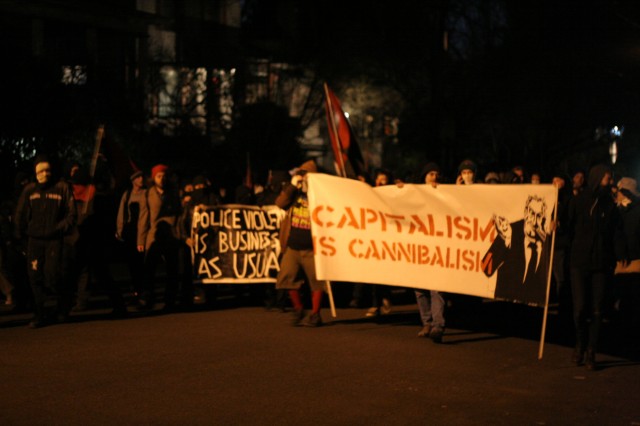
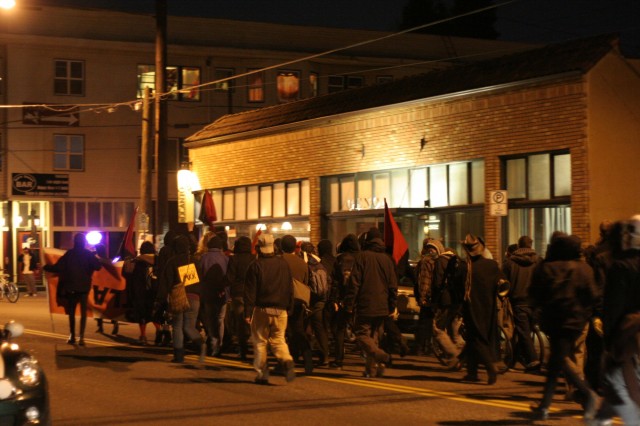
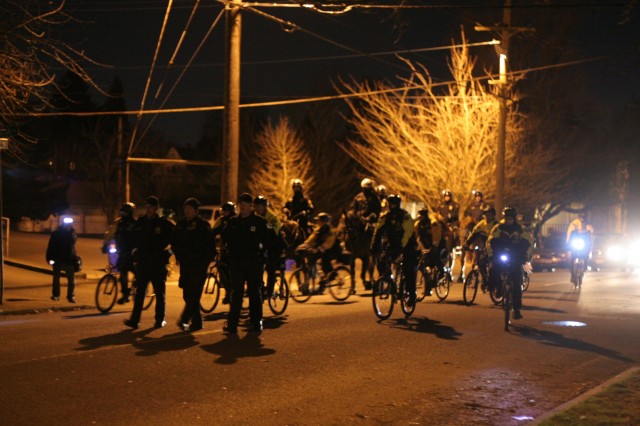
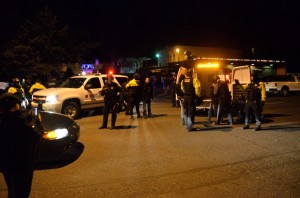
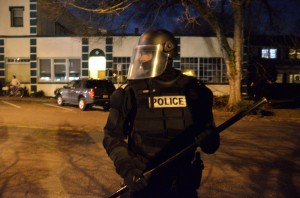
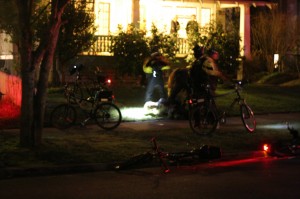
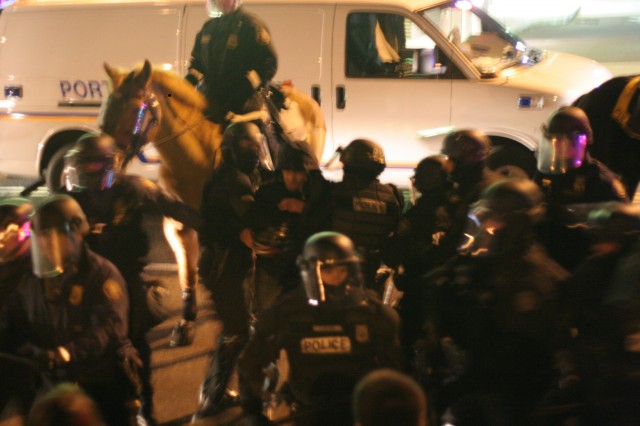
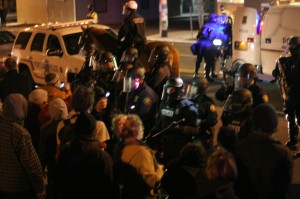
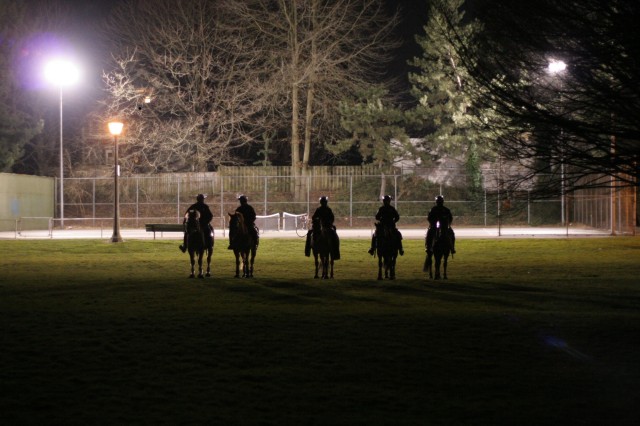
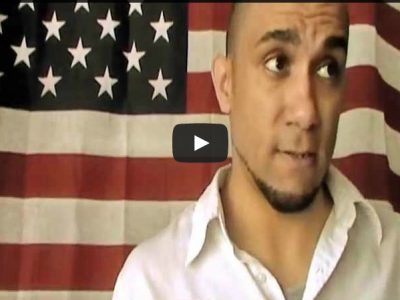
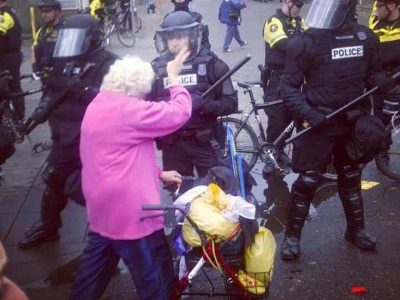
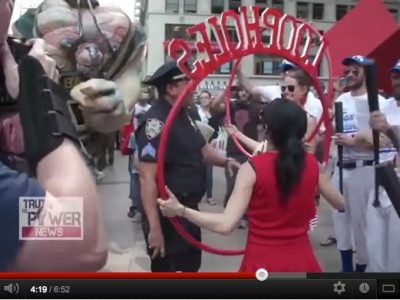
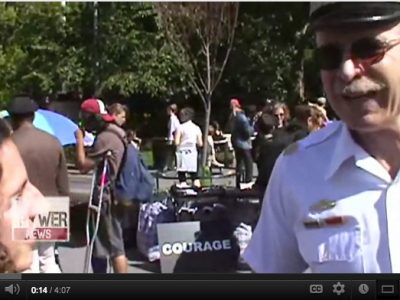
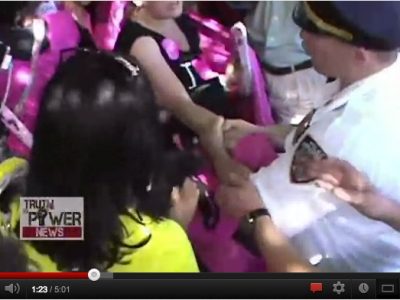
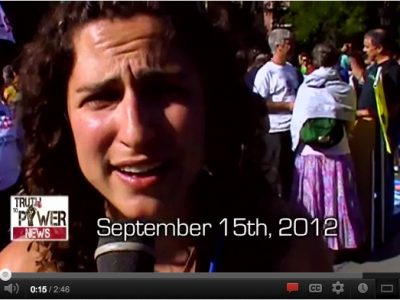
16 comments for “Portland Police Prove the Point of Anti-Police Brutality March”